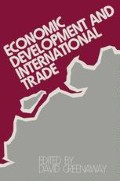Abstract
The concept of comparative advantage is rightly regarded as one of the triumphs of economic thought. It has long served as a guide for principles of action, not only for countries but also for any economic organisation which aspires to a rational allocation of resources. Although widely accepted, the concept remains a product of abstract economic thought, and the quantification of comparative advantage has proven to be elusive. This chapter focuses on this particular aspect, which is only part of a much larger literature on the subject of comparative advantage.
The author acknowledges the helpful comments of Helmut Forstner and Tracy Murray, but is himself responsible for any errors and omissions. The views expressed in this article are personal and not necessarily those of UNIDO.
Preview
Unable to display preview. Download preview PDF.
Editor information
Editors and Affiliations
Copyright information
© 1988 Robert H. Ballance
About this chapter
Cite this chapter
Ballance, R.H. (1988). Trade Performance as an Indicator of Comparative Advantage. In: Greenaway, D. (eds) Economic Development and International Trade. Palgrave, London. https://doi.org/10.1007/978-1-349-19174-1_2
Download citation
DOI: https://doi.org/10.1007/978-1-349-19174-1_2
Publisher Name: Palgrave, London
Print ISBN: 978-0-333-42493-3
Online ISBN: 978-1-349-19174-1
eBook Packages: Palgrave Business & Management CollectionBusiness and Management (R0)

